by Elisabeth Ernst-McNeil, 2009
Lamu
Lamu, Kenya
is a small town on Lamu Island. It is some 350 km northeast of Mombasa. It is a UNESCO World Heritage site and Kenya's oldest continually inhabited town. It was one of the original Swahili settlements along coastal East Africa, founded in 1370.
The history and geography of Lamu are in every relevant school-book. Details of its grim past as a slave-trading centre are not so well known, but also documented. When the trade in “black ivory” became illegal in 1907, Lamu’s economy slumped. ‘Nuff said.
Shunning the beaches of Mombasa (too many hotels, tourists, and worrying reports of violence) we arrived in Lamu on a Monday in September and were ferried to the town (the airfield is on an island opposite the town) in a boat that had definitely seen better days, like so much in East Africa. The man whose task it was to hold in place the plastic tube leading from the (open) fuel can to the motor had a lighted cigarette dangling from his lips. Another man had to crank the motor to start it.
The way from the waterfront to where we would be staying took us past a large rubbish-dump where donkeys, dogs, cats, hens and small children patiently searched for eatables. There are more than 2000 donkeys in Lamu, and there is (fortunately) also a Donkey Sanctuary – the animals are mostly used for very heavy work and some of them are in an appalling state.

The loads the donkeys carry are sometimes horrendous
Photo ©: Elisabeth Ernst-McNeil 2009

The men who loaded them with building materials certainly seemed to find them heavy
Photo ©: Elisabeth Ernst-McNeil 2009

Experienced animals know the route they have to take and are often unaccompanied
Photo ©: Elisabeth Ernst-McNeil 2009

They have to be people-carriers, too
Photo ©: Elisabeth Ernst-McNeil 2009

Some people are weightier than others
Photo ©: Elisabeth Ernst-McNeil 2009

There is always room in Lamu to park your donkey
Photo ©: Elisabeth Ernst-McNeil 2009
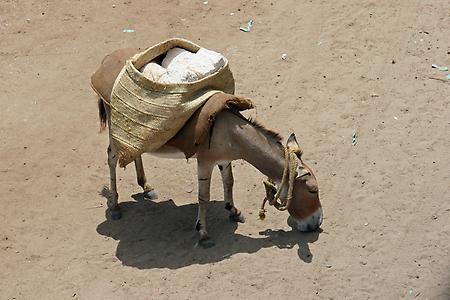
Even during working hours a donkey sometimes has a few minutes to itself
Photo ©: Elisabeth Ernst-McNeil 2009

Fortunately some loads are not as heavy as they look
Photo ©: Elisabeth Ernst-McNeil 2009

If you are really in a hurry, man-power is sometimes more reliable for shifting loads
Photo ©: Elisabeth Ernst-McNeil 2009
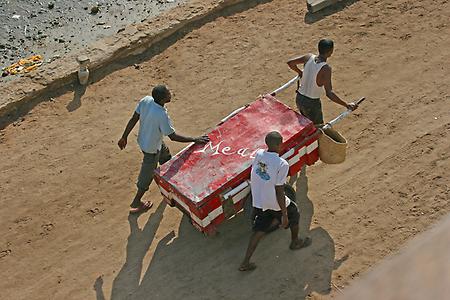
Meat has to travel from the slaughter-house at top speed in Lamu’s climate
Photo ©: Elisabeth Ernst-McNeil 2009
The roads and alleyways are much too narrow for cars, so instead of horsepower read donkey-power. Lamu had two motor vehicles in 2009 – the District Commissioner’s car, and the ambulance which doubled as a bus-cum-taxi.
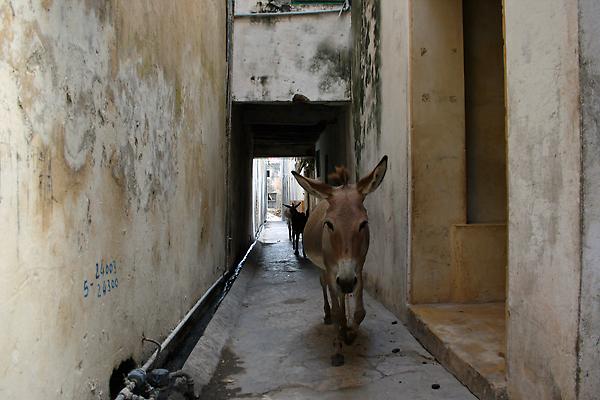
Never argue with a donkey about who goes first
Photo ©: Elisabeth Ernst-McNeil 2009

It is cool in the shade of the houses, even in the heat of the day
Photo ©: Elisabeth Ernst-McNeil 2009
Donkeys always have the right of way and they are so much an institution in Lamu that the annual donkey race is perhaps the best-known part of the Maulidi Festival there, although the dhow race also has a rich tradition. The local cats are a feature of the place, too – thin whippy animals with big ears and loud voices, they are said to be direct descendants of the cats worshipped by the ancient Egyptians and are assumed to have come to Lamu on trading ships from Egypt.

The cats gather when fishing-boats come in
Photo ©: Elisabeth Ernst-McNeil 2009

A cat with attitude
Photo ©: Elisabeth Ernst-McNeil 2009
As you’d expect from a coastal settlement, the sea plays and always has played an important role for the people of Lamu: Lamu Town dates back to the 14th century and the area was settled long before that.

Part of the Omani fort built in the 19th century. It now houses a museum
Photo ©: Elisabeth Ernst-McNeil 2009
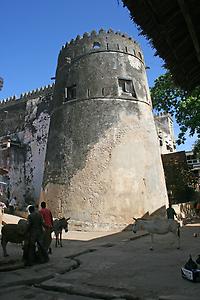
The main tower of the fort
Photo ©: Elisabeth Ernst-McNeil 2009

Some of the roofs in town are in need of repair
Photo ©: Elisabeth Ernst-McNeil 2009

Carved wooden doors are a speciality of East Africa, and particularly of Lamu
Photo ©: Elisabeth Ernst-McNeil 2009

A more superior residential area
Photo ©: Elisabeth Ernst-McNeil 2009
Unfortunately there is no jetty for the fishermen, and so their boats are stranded on the mud-flats at ebb-tide. This also means they often can’t land their catch when it’s fresh. Of course, the promised Chinese investment in Lamu may now have changed all that as the town is destined to become the new Kenyan mega-port.

Loading the boat at low tide
Photo ©: Elisabeth Ernst-McNeil 2009

Children here have few technical toys
Photo ©: Elisabeth Ernst-McNeil 2009

Waiting for the tide, time for a chat
Photo ©: Elisabeth Ernst-McNeil 2009

Waiting for the tide
Photo ©: Elisabeth Ernst-McNeil 2009

Man and beast just have to sit and wait – patience is a virtue
Photo ©: Elisabeth Ernst-McNeil 2009

Anyone working on a boat can be sure of an audience
Photo ©: Elisabeth Ernst-McNeil 2009

There’s no shortage of helping hands
Photo ©: Elisabeth Ernst-McNeil 2009

A ray
Photo ©: Elisabeth Ernst-McNeil 2009
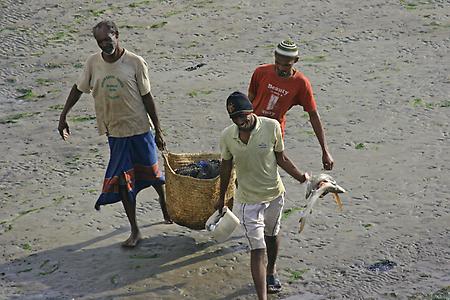
Bringing in the catch
Photo ©: Elisabeth Ernst-McNeil 2009
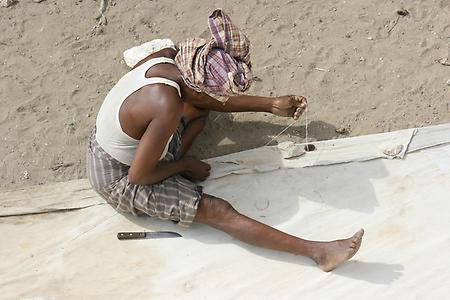
Mending the sail
Photo ©: Elisabeth Ernst-McNeil 2009

Fishing in shallow water
Photo ©: Elisabeth Ernst-McNeil 2009
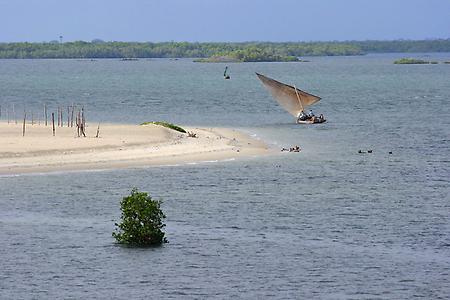
A boat more suited for carrying goods
Photo ©: Elisabeth Ernst-McNeil 2009

Boats tend to be overloaded
Photo ©: Elisabeth Ernst-McNeil 2009

The ferries are no exception
Photo ©: Elisabeth Ernst-McNeil 2009

It comes as a surprise that some boats still float
Photo ©: Elisabeth Ernst-McNeil 2009

They don’t always look seaworthy
Photo ©: Elisabeth Ernst-McNeil 2009

Sacred ibises scavenge on the mudflats
Photo ©: Elisabeth Ernst-McNeil 2009

Marabou storks are also present in large numbers
Photo ©: Elisabeth Ernst-McNeil 2009

There are rich pickings for any numbers of scavengers in the rubbish
Photo ©: Elisabeth Ernst-McNeil 2009
The inhabitants of Lamu are a mixture of peoples – of Bantu origin, Arab, Indian, Somali, to name just a few.

Bright colours are favoured
Photo ©: Elisabeth Ernst-McNeil 2009
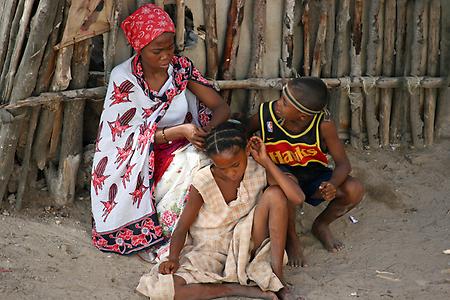
A hair-do for a special occasion
Photo ©: Elisabeth Ernst-McNeil 2009

Traditionally a womans task
Photo ©: Elisabeth Ernst-McNeil 2009

By no means all women were fully veiled in public
Photo ©: Elisabeth Ernst-McNeil 2009

Some were, some weren’t
Photo ©: Elisabeth Ernst-McNeil 2009

Combining modern means of communication with traditional means of transport
Photo ©: Elisabeth Ernst-McNeil 2009

Some Masai come to the coastal areas to try to earn a little money
Photo ©: Elisabeth Ernst-McNeil 2009
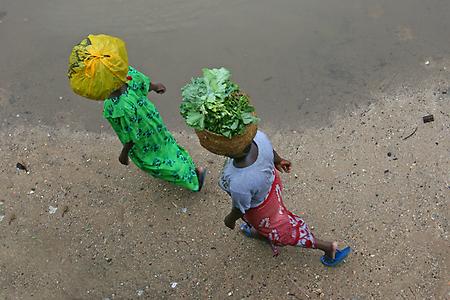
Bringing the shopping home
Photo ©: Elisabeth Ernst-McNeil 2009

Swahili women are the fruit and vegetable vendors in the market
Photo ©: Elisabeth Ernst-McNeil 2009

They are astute business women
Photo ©: Elisabeth Ernst-McNeil 2009

The men often wear a kikoy, the traditional wrap-around skirt-like garment
Photo ©: Elisabeth Ernst-McNeil 2009
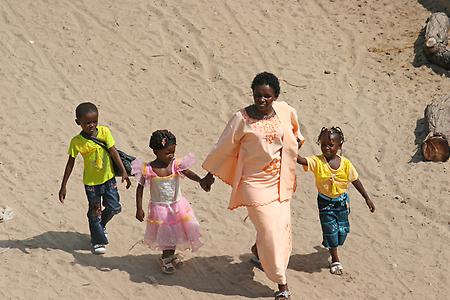
Dressed in their Sunday best
Photo ©: Elisabeth Ernst-McNeil 2009
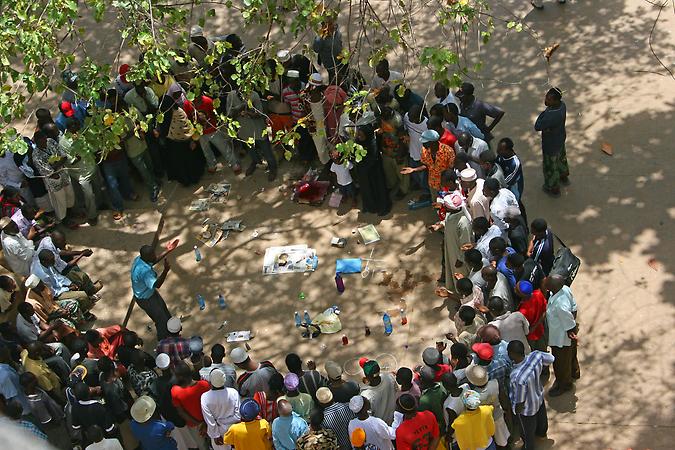
A magic potion salesman?
Photo ©: Elisabeth Ernst-McNeil 2009
Ali Hippy is a Swahili and an institution. We had heard that he would cook for you in his house in the evening and he and his children would play Swahili folk-songs for visitors. Contact was duly made, Ali named the price, and we arranged a date and time. We would be eating fish, we were told, and one of his sons would fetch us. At the appointed time his son, a gangling youth, appeared, gestured that we should follow him, and strode off at speed, with us struggling to keep up.
Ali’s house was in what seemed to be a separate village, quite some way from the outskirts of Lamu Town where we were staying. It was growing dark as we reached it and Ali Hippy invited us to sit in his yard, where a blanket had been spread out on the ground for us. A small fire was burning in the centre of the yard, and that was the only light. Ali’s wife and several children brought us the fish, which was in a rich sauce and served with ugali, which is Swahili for the basic maize flour dish eaten in the whole of East Africa. As if it were plasticine, you can form a kind of spoon with it for food that would otherwise be a problem without cutlery. One of us remarked to Ali that his wife seemed very young to have so many children, and he explained that this was his second wife. “I have seven children with my first wife, so I had to divorce her because she wouldn’t take the tablets.”
If you go to Lamu, we’d been told, you must take a boat trip in a dhow, preferably to Shela Beach.

A dhow, easily recognizable by its triangular sail
Photo ©: Elisabeth Ernst-McNeil 2009
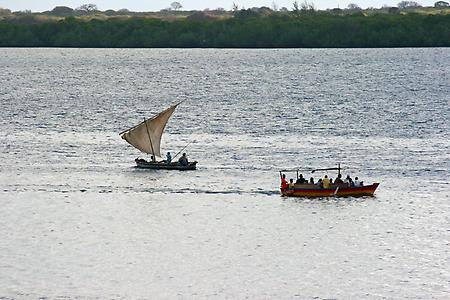
Dhows come in different shapes and sizes
Photo ©: Elisabeth Ernst-McNeil 2009

Dhows often look elegant
Photo ©: Elisabeth Ernst-McNeil 2009
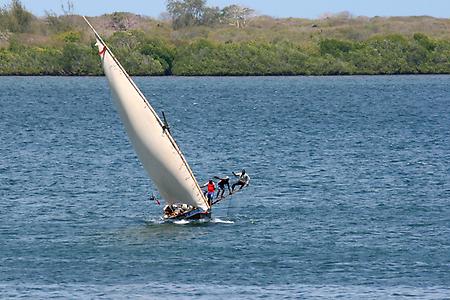
Acrobatics on the outrigger
Photo ©: Elisabeth Ernst-McNeil 2009
So we did. We chose a boat captained improbably by Omar Sharif (that’s what he said he was called) and on the way to Shela Beach we learned that dhows are extremely difficult to steer, seem to need bailing an awful lot, require balancing acts with an outrigger, and that we really should have chosen one with a motor. The beach, when we finally reached it, was a bit of a let-down. While there was nothing wrong with it, I’ve been on beaches just as beautiful far nearer home.
The rainy season started sooner than we had been expecting, and with it our stay in Lamu came to an end. I think I can truly say it was unforgettable.






















































